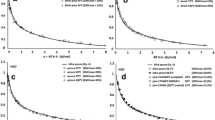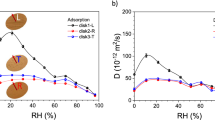Abstract
A new method of wood moisture sorption analysis is presented using sorption isotherms of a series of mildly heat-treated specimens with varied and known elemental composition. This method allows the determination of the occupancy of accessible sorption sites in wood as a function of relative humidity h, θ(h) ≈ h, found in agreement with the literature data on the non-freezing water occupancy of hydroxyl groups for h < 0.9. Complementary sorption isotherm shape analysis identifies an empirical power law occupancy function, θ(h) = h α, α ≈ 0.73, which is close to the former two determinations in the same humidity range. The validity of widely accepted surface sorption theories for wood with a strongly bound primary layer and loosely bound secondary layers is disproven. To explain the found occupancy function, θ(h) ≈ h, a near-ideal liquid mixture of moisture and polar dynamic microvoids in the cell wall substance is postulated. The power law occupancy function is used to calculate the humidity-dependent number of sorption sites in adsorption/desorption isotherms to show that (1) the number of sorption sites from the adsorption line monotonically increases with increasing humidity—argued to represent the equilibrium number of sorption sites at each humidity, and (2) the number of sorption sites from the desorption line fails to fully return to that of the (equilibrium) adsorption line. Hysteresis is quantitatively explained as the result of non-equilibrium excess sorption sites being occupied according to the occupancy law. The relaxation of non-equilibrium excess sorption sites is satisfactorily modeled by a first-order rate equation. Applying the analysis to study mild thermal modification of moisture sorption isotherms revealed that (1) moisture contents decrease directly linear to the removed amount of sorption sites at all humidity <0.95, and (2) the absolute hysteresis is nearly unaffected as a result of counter-acting effects of the reduced number of sorption sites and reduced amount of relaxation.











Similar content being viewed by others
References
Almeida G, Hernández RE (2006) Changes in physical properties of tropical and temperate hardwoods below and above the fiber saturation point. Wood Sci Technol 40:599–613
Barkas WW (1949) The swelling of wood under stress. HM Stationary Office, London
Berthold J, Rinaudo M, Salmén L (1996) Association of water to polar groups—estimations by an adsorption model for ligno-cellulosic materials. Colloid Surf A 112:117–129
Borrega M, Kärenlampi PP (2008) Effect of relative humidity on thermal degradation of Norway spruce (Picea abies) wood. J Wood Sci 54:323–328
Borrega M, Kärenlampi PP (2010) Hygroscopicity of heat-treated Norway spruce (Picea abies) wood. Eur J Wood Prod 68:233–235
Caulfield DF, Weatherwax RC (1978) Tensile modulus of paper wet-stiffened by crosslinking. In: Fiber-water interactions in papermaking: transactions of the symposium held at Oxford 1977, vol 2, pp 741–763
Chaouch M (2011) Effect of the treatment intensity on the elemental composition and the durability of heat-treated wood: development of a marker for the prediction of the Basidiomycete fungal resistance. (In French) Dissertation, University of Lorraine
Chaouch M, Dumarçay S, Pétrissans A, Pétrissans M, Gérardin P (2013) Effect of heat treatment intensity on some conferred properties of different European softwood and hardwood species. Wood Sci Technol 47:663–673
Chirkova J, Andersons B, Andersone I (2009) Study of the structure of wood-related biopolymers by sorption methods. BioResources 4:1044–1057
Chow SZ (1972) Hydroxyl accessibility, moisture content, and biochemical activity in cell walls of Douglas-fir trees. Tappi 55:539–544
Ding T, Gu L, Liu X (2011) Influence of steam pressure on chemical changes of heat-treated Mongolian pine wood. BioResources 6:1880–1889
Engelund E, Thygesen L, Svensson S, Hill CAS (2013) A critical discussion of the physics of wood–water interactions. Wood Sci Technol 47:141–161
Ferrari S, Ignazia Cuccui I, Allegretti O (2013) Thermo-vacuum modification of some European softwood and hardwood species treated at different conditions. BioResources 8:1100–1109
Filpponen I, Argyropoulos DS, Lucia L (2008) Determination of the accessible hydroxyl groups in cellulose by using phosphitylation and 31P NMR spectroscopy. Ind Eng Chem Res 47:8906–8910
Geerlings P, De Proft F, Langenaeker W (2003) Conceptual density functional theory. Chem Rev 103:1793–1873
Glass SV, Zelinka SL (2010) Moisture relations and physical properties of wood. In: Wood Handbook, Chapter 04: General Technical Report FPL-GTR-190. U.S. Department of Agriculture, Forest Service, Forest Products Laboratory, Madison, pp 1–19
González-Peña MM, Breese MC, Hale MDC (2005) Studies on the relaxation of heat-treated wood. In: Militz H, Hill C (eds) Wood modification: processes properties and commercialization. Georg-August University Press, Göttingen, pp 87–90
Hailwood AJ, Horrobin S (1946) Absorption of water by polymers: analysis in terms of a simple model. Trans Faraday Soc 42B:84–92
Hartley ID, Avramidis S (1993) Analysis of the wood sorption isotherm using clustering theory. Holzforschung 47:163–167
Hill CAS (2006) Wood modification—chemical, thermal and other processes. Wiley, Chichester
Hill CAS (2008) The reduction in the fibre saturation point of wood due to chemical modification using anhydride reagents: a reappraisal. Holzforschung 62:423–428
Hill CAS, Norton A, Newman G (2010) The water vapour sorption properties of Sitka spruce determined using a dynamic vapour sorption apparatus. Wood Sci Technol 44:497–514
Jalaludin Z (2012) The water vapour sorption behaviour of wood. PhD thesis, Edinburgh Napier University
Jalaludin Z, Hill CAS, Xie Y, Samsi HW, Awang K, Curling SF (2010) Analysis of the water vapour sorption isotherms of thermally modified acacia and sesendok. Wood Mater Sci Eng 5:194–203
Jenkins HDB (2008) Chemical thermodynamics at a glance. Wiley, Oxford
Keating B, Hill CAS, Sun D, English R, Davies P, McCue C (2013) The water vapor sorption behavior of a galactomannan cellulose nanocomposite film analyzed using parallel exponential kinetics and the Kelvin–Voigt viscoelastic model. J Appl Polym Sci. doi:10.1002/app.39132
Lam PS (2011) Steam explosion of biomass to produce durable wood pellets. Dissertation, University of British Columbia
Militz H (2002) Heat treatment of wood: European processes and their background, In: The international research group on wood protection, document no IRG/WP 02-40241
Navi P, Sandberg D (2012) Thermo-hydro-mechanical processing of wood. EFPL Press, Lausanne
Nguila-Inari G, Pétrissans M, Pétrissans A, Gérardin P (2009) Elemental composition of wood as a potential marker to evaluate heat treatment intensity. Polym Degrad Stab 94:365–368
Nguyen TC, Wagenführ A, Phuong LX, Dai VH, Bremer M, Fischer S (2012) Effects of thermal modification on the properties of two Vietnamese bamboo species, Part I: effects on physical properties. BioResources 7:5355–5365
Pach M, Zanzi R, Björnbom E (2002) Torrefied biomass a substitute for wood and charcoal. In: Proceedings of the 6th Asia-Pacific international symposium on combustion and energy utilization. Kuala Lumpur
Patera A, Derome D, Griffa M, Carmeliet J (2013) Hysteresis in swelling and in sorption of wood tissue. J Struct Biol 182:226–234
Pfriem A, Zauer M (2009) Alteration of the unsteady sorption behaviour of spruce and maple due to thermal treatment. In: The Fourth European Conference on Wood Modification ECWM4 Proceedings. Stockholm, Sweden, pp 363–369
Phuong LX, Takayama M, Shida S, Matsumoto Y, Aoyagi T (2007) Determination of the accessible hydroxyl groups in heat treated Styrax tonkinensis (Pierre) Craib ex Hartwich wood by hydrogen-deuterium exchange and 2H NMR spectroscopy. Holzforschung 61:488–491
Polanyi M (1916) Adsorption of gases (vapors) by a solid non-volatile adsorbent. Verh Dtsch Phys Ges 18:55–80
Popper R, Niemz P, Croptier S (2009) Adsorption and desorption measurements on selected exotic wood species. Analysis with the Hailwood-Horrobin model to describe the sorption hysteresis. Wood Res 54:43–56
Prins MJ (2005) Thermodynamic analysis of biomass gasification and torrefaction. PhD Thesis, Eindhoven University of Technology
Sanderson RT (1951) An Interpretation of bond lengths and a classification of bonds. Science 114:670–672
Shmulsky R, Kadir K, Erickson R (2001) Effect of sample geometry on EMC and moisture hysteresis of red oak. Wood Fiber Sci 33:662–666
Skaar C (1988) Wood-water relations. Springer, Berlin
Straže A, Pervan S, Sedlar T, Gorišek Ž (2012) Analysis of mechanical and rheological properties of heat treated and innate beechwood by non-destructive testing. In: the proceedings of the Sixth European Conference on Wood Modification. Ljubljana, pp 231–234
Suchy M, Virtanen J, Kontturi E, Vuorinen T (2010) Impact of drying on wood ultrastructure observed by deuterium exchange and photoacoustic FT-IR spectroscopy. Biomacromolecules 11:515–520
Taniguchi T, Harada H, Nakato K (1978) Determination of water adsorption sites in wood by a hydrogen–deuterium exchange. Nature 272:230–231
Thygesen LG, Elder T (2009) Moisture in untreated, acetylated, and furfurylated Norway Spruce monitored during drying below fiber saturation using time domain NMR. Wood Fiber Sci 41:194–200
Urquhart AR, Williams AM (1929) The mechanism of the adsorption of water by cotton. J Text Inst 20:T125–T132
Vrentas JS, Vrentas CM (1991) Sorption in glassy-polymers. Macromolecules 24:2404–2412
Vrentas JS, Vrentas CM (1996) Hysteresis effects for sorption in glassy polymers. Macromolecules 29:4391–4396
White HJ, Eyring H (1947) The adsorption of water by swelling high polymeric materials. Text Res J 17:523–553
Willems W (2014) Hydrostatic pressure and temperature dependence of wood moisture sorption isotherms. Wood Sci Technol. doi:10.1007/s00226-014-0616-5
Willems W, Mai C, Militz H (2013) Thermal wood modification chemistry analyzed using van Krevelen’s representation. Int Wood Prod J 4:166–171
Zaihan J, Hill CAS, Curling S, Hashim WS, Hamdan H (2009) Moisture adsorption isotherms of Acacia mangium and Endospermum malaccense using dynamic vapour sorption. J Trop For Sci 21:277–285
Zaihan J, Hill CAS, Curling S, Hashim WS, Hamdan H (2010) The kinetics of water vapour sorption: analysis using parallel exponential kinetics model on six Malaysian hardwoods. J Trop For Sci 22:107–117
Zauscher S, Caulfield DF, Nissan AH (1996) The influence of water on the elastic modulus of paper Part 1: extension of the H-Bond theory. Tappi J 79:178–182
Zelinka SL, Lambrecht MJ, Glass SV, Wiedenhoeft AC, Yelle DJ (2012) Examination of water phase transitions in Loblolly pine and cell wall components by differential scanning calorimetry. Thermochim Acta 533:39–45
Zillig W (2009) Moisture transport in wood using a multiscale approach. PhD thesis, Leuven
Author information
Authors and Affiliations
Corresponding author
Rights and permissions
About this article
Cite this article
Willems, W. The water vapor sorption mechanism and its hysteresis in wood: the water/void mixture postulate. Wood Sci Technol 48, 499–518 (2014). https://doi.org/10.1007/s00226-014-0617-4
Received:
Published:
Issue Date:
DOI: https://doi.org/10.1007/s00226-014-0617-4




